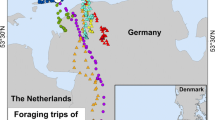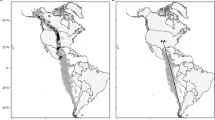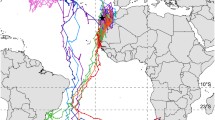Abstract
Because energy reserves limit flight range, wind assistance may be of crucial importance for migratory birds. We tracked eight Bewick’s swans Cygnus columbianus bewickii, using 95-g satellite transmitters with altimeters and activity sensors, during their spring migration from Denmark to northern Russia in 1996. During the 82 occasions where a swan’s location was recorded in flight, average flight altitude was 165 m a.s.l. with a maximum of 759 m a.s.l., despite winds often being more favourable at higher altitudes. We also counted Bewick’s swans departing from the Gulf of Finland and subsequently passing an observatory in the next major stop-over area 800 km further north in the White Sea, northern Russia, during the springs of 1994, 1995 and 1996. A comparison of these counts with wind data provided evidence for Bewick’s swans using favourable changes in wind conditions to embark on migration. Changes in the numbers of birds arriving in the White Sea correlated best with favourable changes in winds in the Gulf of Finland 1 day earlier. Again, migratory volume showed a correlation with winds at low altitudes only, despite wind conditions for the swans being more favourable at high altitudes. We conclude that the relatively large Bewick’s swan tends to gear its migration to wind conditions at low altitude only. We argue that Bewick’s swans do not climb to high altitudes because of mechanical and physiological limitations with respect to the generation of power for flight and to avoid rapid dehydration.






Similar content being viewed by others
References
Alerstam T (1978) Analysis and a theory of visible bird migration. Oikos 30:273–349
Alerstam T (1990) Bird migration. Cambridge University Press, Cambridge
Alerstam T, Bauer CA (1973) A radar study of the spring migration of the Crane (Grus grus) over the southern Baltic area. Vogelwarte 27:1–16
Beekman JH (1997) International censuses of the north-west European Bewick’s Swan population, January 1990 and 1995. Swan Specialist Group Newsletter 6:7–9
Beekman JH, Berthold P, Nowak E, Querner U (1996) Implementation of satellite tracking in studying migration of Anatidae: an overview and a case study. In: Birkan M, Van Vessem J, Havet P, Madsen J, Trolliet B, Moser M (eds) Proc Anatidae 2000 Conf :157–176
Beekman JH, Nolet BA, Klaassen M (2002) Skipping swans: fuelling rates and wind conditions determine differential use of migratory stopover sites of Bewick’s Swans Cygnus bewickii. Ardea 90:437–460
Bergman G (1978) Effects of wind conditions on the autumn migration of waterfowl between the White Sea and the Baltic region. Oikos 30:393–397
Black JM (1988) Preflight signalling in swans: a mechanism for group cohesion and flock formation. Ethology 79:143–157
Blokpoel H, Richardson WJ (1978) Weather and spring migration of snow geese across southern Manitoba. Oikos 30:350–363
Carmi N, Pinshow B, Porter WP, Jaeger J (1992) Water and energy limitations on flight duration in small migrating birds. Auk 109:268–276
Elkins N (1979) High altitude flight by swans. Br Birds 72:238–239
Hedenström A, Alerstam T (1992) Climbing performance of migrating birds as a basis for estimating limits for fuel-carrying capacity and muscle work. J Exp Biol 164:19–38
Klaassen M (1996) Metabolic constraints on long-distance migration in birds. J Exp Biol 199:57–64
Klaassen M, Kvist A, Lindström Å (1999) How body water and fuel stores affect long distance flight in migrating birds. In: Adams NJ, Slotow RH (eds) Proc Int Ornithol Congr 22: 1450–1467
Manville RM (1963) Altitude record for mallard. Wilson Bull 75:92
Nolet BA, Drent RH (1998) Bewick’s Swans refuelling on pondweed tubers in the Dvina Bay (White Sea) during their spring migration: first come, first served. J Avian Biol 29:574–581
Nolet BA, Andreev VA, Clausen P, Poot MJM, Wessel EGJ (2001) Significance of the White Sea as a stopover for Bewick’s Swans Cygnus columbianus in spring. Ibis 143:63–71
Ostapenko VA (1991) Migration of Bewick’s Swans Cygnus bewickii and Whooper Swans C. cygnus wintering in Japan through Sakhalin Island and adjacent territories, U.S.S.R. In: Sears J, Bacon PJ (eds) Proc IWRB Int Swan Symp 3:209–213
Pennycuick CJ (1989) Bird flight performance: a practical calculation manual. Oxford University Press, Oxford
Pennycuick CJ, Einarsson Ó, Bradbury TAM, Owen M (1996) Migrating Whooper Swans: satellite tracks and flight performance calculations. J Avian Biol 27:118–134
Pennycuick CJ, Bradbury TAM, Einarsson Ó, Owen M (1999) Response to weather and light conditions of migrating Whooper Swans Cygnus cygnus and flying height profiles, observed with the Argos satellite system. Ibis 141:434–443
Piersma T, Jukema J (1990) Budgeting the flight of a long distance migrant: changes in nutrient reserve levels of Bar-tailed Godwits at successive spring staging sites. Ardea 78:315–338
Piersma T, Van de Sant S (1992) Pattern and predictability of potential wind assistence for waders and geese migrating from West Africa and the Wadden Sea to Siberia. Ornis Svecica 2:55–66
Piersma T, Klaassen M, Bruggemann JH, Blomert A-M, Gueye A, Ntiamoa-Baidu Y, Van Brederode NE (1990) Seasonal timing of the spring departure of waders from the Banc d’Arguin, Mauretania. Ardea 78:123–134
Richardson WJ (1978) Timing and amount of bird migration in relation to weather: a review. Oikos 30:224–272
Sladen WJL, Gunn WWH, Cochran WW (1969) Studies on the migrations of the Whistling Swan. Proc World Conf Bird Hazards to Aircraft. Queens University, Kingston
Swan LW (1970) Goose of the Himalayas. Nat Hist 79:68–75
Ward DH, Flint PL (1995) Effects of harness-attached transmitters on premigration and reproduction of Brant. J Wildl Manage 59:39–46
Acknowledgements
We are grateful to Bjarke Laubek, Jeroen Nienhuis, Erik Wessel, Stef van Rijn and Birte Hansen for help during catching. Peter and Hanne Laubek are acknowledged for kindly hosting an entire Dutch catch and film crew at their home in Denmark. We greatly benefited from information provided by our Russian colleagues in St. Petersburg and Petrozavodsk, notably V.A. Buzun, S.P. Rezvyi, G.A. Noskov and V.B. Zimin, about swan migration and ice conditions in spring in the Gulf of Finland and the great Karelian lakes Ladoga and Onega. We acknowledge the Meteorological Office, and in particular Pjotr A. Malygin of the Mud’yug weather station, for their hospitality and permission to make use of the observation tower. We also thank Valery A. Andreev of the Committee of Environment Protection and Natural Resources of Arkhangelsk Region for his valuable co-operation. Rudi Drent paved the way for studying migratory waterfowl on Mud’yug Island. Ânne Dekinga, Rudi Drent, Martin Epe, Anita Koolhaas, Oscar Langevoord, Martin Poot, Jeroen Nienhuis and Erik Wessel all spent long cold hours on the tower. Thomas Alerstam kindly allowed us access to his unpublished flight altitude data. Ten Dekkers, Harry Korthals and Melanie Paschke assisted in the careful analysis of the synoptic weather maps. Rudi Drent, Birgit Erni, Martin Green, Anders Hedenström and Felix Liechti gave valuable comments on earlier versions of the manuscript. This research was funded by the Netherlands Organization for Scientific Research (NWO-grant 047–002–008), the Beijerinck-Popping Fonds, the Groninger Universiteits Fonds and the Fonds voor Onderzoek der Natuur. This is publication 3288 of the Netherlands Institute of Ecology.
Author information
Authors and Affiliations
Corresponding author
Additional information
Communicated by F. Bairlein
Rights and permissions
About this article
Cite this article
Klaassen, M., Beekman, J.H., Kontiokorpi, J. et al. Migrating swans profit from favourable changes in wind conditions at low altitude. J Ornithol 145, 142–151 (2004). https://doi.org/10.1007/s10336-004-0025-x
Received:
Revised:
Accepted:
Published:
Issue Date:
DOI: https://doi.org/10.1007/s10336-004-0025-x




